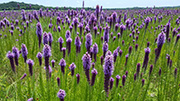Native Plant Conservation Campaign News: Prairie and grassland conservationists and scientists have been playing the long game, and their efforts are paying off.
February 21, 2019
A February 18 Christian Science Monitor
article documents progress in native prairie conservation and restoration across the U.S. The article describes some of the research and strategies that native prairie enthusiasts are using sucessfully to expand prarie ecosystems.
Excerpts from the article:
…. Over the last three decades, a dedicated community of conservationists and land managers has worked to preserve American grasslands in all their manifold forms: the tallgrass, shortgrass, and mixed-grass prairies of the Midwest, as well as lesser-known varieties, such as the northwest prairies in Oregon and Washington, and the sandplain grasslands in Massachusetts. Since the ’80s, conservationists have make significant progress in their ability to reestablish and care for prairie ecosystems.

“The future of prairie restoration is headed in a good direction. We’ve learned some lessons,” says Tom Kaye, executive director and senior ecologist at the Institute for Applied Ecology in Corvallis, Ore. “I think we’ve been able to focus on ... the research that’s necessary to continue to improve.”
And that research has paid off. Advances in seeding technology have allowed land recovered from farming and other uses to be more fully restored with native plants. And reseeded plants have an increased rate of survival, thanks to efforts to understand plant establishment, says Dr. Kaye.
A rough estimate for preserved prairies in the Great Plains area alone is around 207,000 square miles of tall-, mixed-, and shortgrass biomes.
It’s not all smooth sailing, though. “Temperate grasslands are one of the least-protected terrestrial biomes. They are traditionally the places that we have settled and plowed,” says Alison Fox, the chief executive officer of American Prairie Reserve. “The estimates are that less than 5 percent of prairies are in any form of long-term protection.”
From a practical point of view, prairies are good for the environment. “Prairies in particular have high amounts of biological diversity, and that diversity helps sustain life on Earth,” says [Tom] Kaye. “Prairies also are huge carbon sinks.... Restoring prairie ties up a lot of carbon, so that it’s not in the atmosphere.”
Photo Prairie Blazing Star (c) Eric Hunt Arkansas Native Plant Society
 “The future of prairie restoration is headed in a good direction. We’ve learned some lessons,” says Tom Kaye, executive director and senior ecologist at the Institute for Applied Ecology in Corvallis, Ore. “I think we’ve been able to focus on ... the research that’s necessary to continue to improve.”
“The future of prairie restoration is headed in a good direction. We’ve learned some lessons,” says Tom Kaye, executive director and senior ecologist at the Institute for Applied Ecology in Corvallis, Ore. “I think we’ve been able to focus on ... the research that’s necessary to continue to improve.”